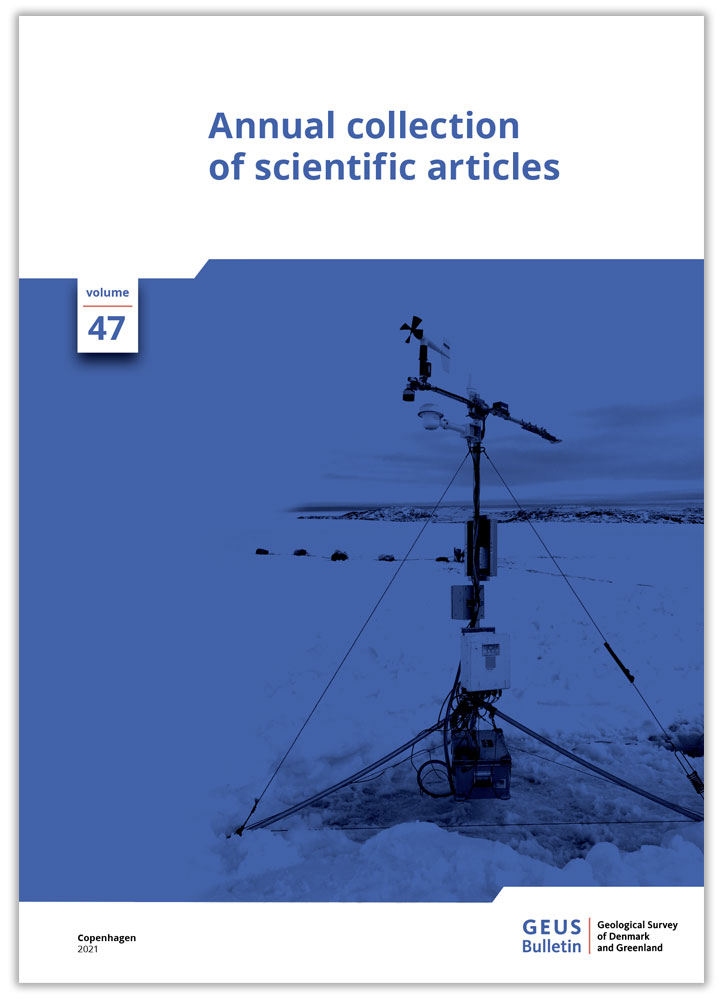GEUS Bulletin is a peer-reviewed, diamond open access journal published by the Geological Survey of Denmark and Greenland (GEUS). We publish geoscience research papers, monographs and map descriptions for Denmark, Greenland and the Arctic region. GEUS Bulletin believes that open science benefits scientists, industry and society. We do not charge publication fees and all our articles can be freely downloaded online. IF 2022: 1.7; 5-year IF: 1.8 (Source: Journal Citation Report 2023).
Archives
-
Annual Volume 2024
Vol. 57 (2024)An annual collection of articles submitted to GEUS Bulletin and published throughout 2024. This issue is open until the end of 2024.
-
Petrology of the Skaergaard Layered Series
Vol. 56 (2023)Peter Thy, Christian Tegner and Charles E. Lesher
Issue edited by Jakob K. Keiding
The Skaergaard intrusion is a layered, ferrobasaltic intrusion emplaced during the Early Eocene into the rifting volcanic margin of East Greenland. In this special issue the authors, Peter Thy, Christian Tegner and Charles E. Lesher present a comprehensive review of differentiation processes exemplified by the Skaergaard intrusion. They present petrographic, mineralogical and major and trace element data of the Layered Series collected during ground traverses and from a drill core and show that differentiation was principally controlled by crystal fractionation interrupted by liquid immiscibility and the termination of melt convection in the upper parts of the intrusion. They further attribute a decoupling of included and excluded trace elements to the mobility of an immiscible granophyric melt in the mush. Accompanying this special issue is a rich resource of online supplementary data, photomicrographs and modelling results, as well as key maps and aerial photos. It is the hope that this archive will be a valuable long-term resource for studies of the petrology and geochemistry of the Skaergaard intrusion and similar plutons. A foreword is provided by Troels F.D. Nielsen and the Editor of this issue is Jakob K. Keiding, both Geological Survey of Denmark and Greenland.
Cover photo: View of Middle Zone from Kraemer Ø with Wager Top in the centre of the background. (Credit: C. Tegner).
-
The Upper Jurassic – Lower Cretaceous of East and North-East Greenland: Rødryggen-1 and Brorson Halvø-1 boreholes, Wollaston Forland Basin
Vol. 55 (2023)Edited by: Jørgen A. Bojesen-Koefoed, Jon R. Ineson & Karen Dybkjær
The Wollaston Forland Basin in North-East Greenland is a renowned area for research into depositional processes and sedimentary architecture in an evolving rift basin since the pioneering work of Andreas Vischer in the late 1930s. A drilling campaign in 2009–2010 in Wollaston Forland investigated the nature of the sedimentary basin fill in a distal rotated fault block, east of the classical, coarse-grained proximal rift exposures. Two fully cored boreholes, Rødryggen-1 and Brorson Halvø-1, were drilled in the axis and near the crest, respectively, of this distal sub-basin. The organic-rich, mudstone-dominated succession revealed by these boreholes is documented fully in this special issue, which complements the data set from the Blokelv-1 borehole in Jameson Land presented in GEUS Bulletin 42. Together these cored sections represent a unique geological archive from a high latitude setting, recording a key period when super-regional deoxygenation prevailed in the marine waters of the proto-North Atlantic region.
Cover photo: View of Wollaston Forland towards the north, taken from the Rødryggen hill (Credit: J.A. Bojesen-Koefoed 2008).
-
The PGE-Au Mineralisation of the Skaergaard intrusion: precious metal minerals, petrography and ore genesis
Vol. 54 (2023)Guest Editor: Rune B.E. Larsen, NTNU, Norway
The Skaergaard PGE-Au Mineralisation, alias the Platinova Reef, is hosted in a series of mineralisation levels within a suite of bowl-shaped macrorhythmic layers in the upper Middle Zone of the Skaergaard intrusion. The intrusion is exposed 68°N in East Greenland. The occurrence defines its own type due to its exceptional structure and mineralogy. A wealth of mineralogical data is available in laboratory reports for individual samples and in peer-reviewed publications, but none of these account for the lateral and stratigraphic variations in the compositions of the minerals and phases of PGE and Au parageneses in the gabbros of the intrusion. In this special issue, the authors, Nikolay S. Rudashevsky, Troels F.D. Nielsen and Vladimir N. Rudashevsky, collate and describe the mineralogical data for the first-formed PGE-rich and last-formed gold-rich mineralisation levels and integrate these with petrogenetic models. A foreword is provided by the Guest Editor of this special issue, Rune B.E. Larsen.
-
Annual Volume 2023
Vol. 53 (2023)An annual collection of articles submitted to GEUS Bulletin and published throughout 2023. This issue is open until the end of 2023.
-
Marine geodiversity and geosystem services in Scandinavian seas
Vol. 52 (2022)Guest editors: Kaskela Anu (Geological Survey of Finland), Margaret Dolan (Geological Survey of Norway) and Verner Brandbyge Ernstsen (Geological Survey of Denmark and Greenland).
This special issue highlights the application and development of the concepts of geodiversity and geosystem services in a marine context with a specific focus on the Scandinavian regional seas.
The articles published in this issue address the role of marine geodiversity and geosystem services in relation to blue growth, green transition and sustainability and the importance and value of including abiotic components of nature in relation to nature conservation, protection and geoheritage. Hence, this issue promotes key elements for maritime or marine spatial planning and management in the marine realm in a changing climate.
The editors intend for this issue to contribute to the UN Decade of Ocean Science for Sustainable Development by contributing to the scientific knowledge base.
DOI for this issue: https://doi.org/10.34194/geusb.v52i
-

Descriptive text to the Geological map of Denmark, 1:50 000, Møn 1511 I, 1511 IV and 1512 II
Vol. 51 (2022)This is an English translation of Vol. 48 (2021), which was originally published in Danish.
Translated and edited by: Adam A. Garde
Written by: Stig A. Schack Pedersen, Peter Gravesen
The Møn map area covers the islands of Møn, Nyord, Degneholm, Lindholm and Langø. It also includes the south-east corner of Sjælland, Kalvehave and the north-east corner of Falster, Grønsund.
The map sheet description provides the systematic, geological description of the soil types that appear on the geological map. The geology is described to a depth of 60–80 m a.s.l., by four geological cross-sections based on boreholes from the Jupiter database at GEUS.
The near-surface geology on Møn is dominated by clayey till, which covers c. 70% of the land area. Sandy deposits cover c. 20% of the land area and consist of glaciofluvial sand and marine sand. The latter forms the Ulvshale peninsula with an extended crescentic spit and the marine sandflat east of Nyord. In the valleys, postglacial peat is interbedded with freshwater sand and clay, which is particularly characteristic of infill in the former fjord at Borre Sømose.
The Cretaceous chalk at Møns Klint is the most significant geological formation in the area. Here, a series of steep sheets of Cretaceous chalk form parallel hill ridges. The highest point is Aborre Bjerg (143 m a.s.l.). Sheets of Cretaceous chalk are also found elsewhere, including Hvideklint on the south coast of Møn.
-

Lithostratigraphy, geology and geochemistry of the Tertiary volcanic rocks on Svartenhuk Halvø and adjoining areas, West Greenland
Vol. 50 (2022)The upper Cretaceous–Tertiary Nuussuaq Basin in West Greenland contains a thick succession of siliciclastic sediments and overlying volcanic rocks. The first studies in the early 19th century were centred on the coal and fossils in the sediments and minerals in the volcanic rocks. The present focus of interest includes modern stratigraphic and volcanological studies to decipher the basin evolution and support hydrocarbon and mineral exploration.
This special issue of GEUS Bulletin presents the lithostratigraphy, geology and geochemistry of the Paleocene and Lower Eocene volcanic rocks on the Svartenhuk Halvø and adjoining areas to the north and east. The olivine-rich Vaigat Formation is more than 2000 m thick and comprises three members, of which the lowest is crustally contaminated. The basaltic Svartenhuk Formation is up to 1350 m thick and comprises four members. It extends from Svartenhuk Halvø to large areas to the north and east. The basaltic Naqerloq Formation, of early Eocene age, occurs in western Svartenhuk Halvø in erosional remnants up to 300 m thick. The comprehensive descriptions and chemical analyses are intended to serve as a guide for future studies.
This bulletin is a companion to bulletin vol. 39 and vol. 40 on the volcanic rocks of the Vaigat and Maligât Formations on Disko and Nuussuaq.
-
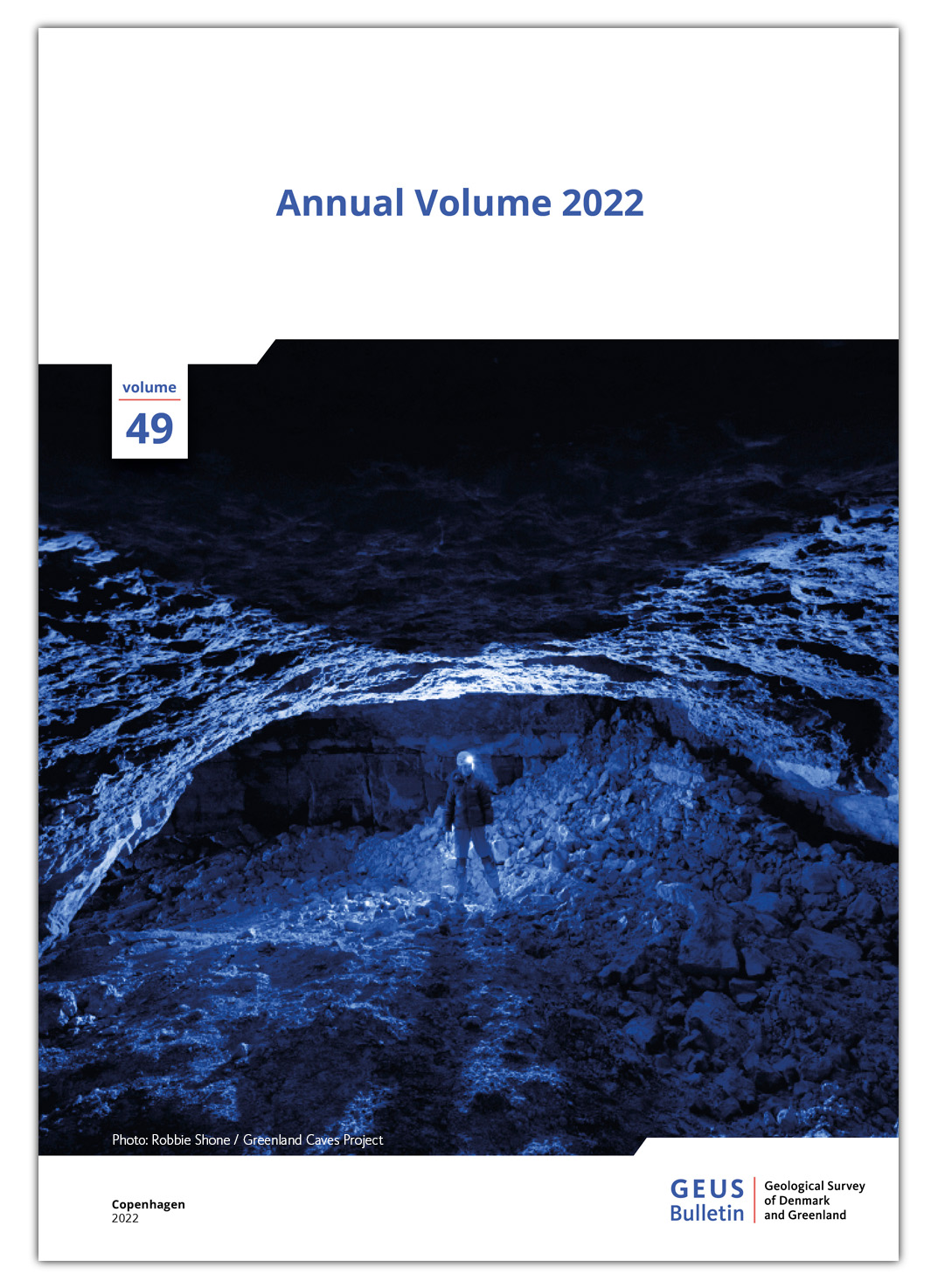
Annual Volume 2022
Vol. 49 (2022)An annual collection of articles submitted to GEUS Bulletin, published throughout 2022.
Cover photo by @Robbie Shone / Greenland Caves Project, as featured in Smith & Moseley (2022; DOI:10.34194/geusb.v49.8298).
-
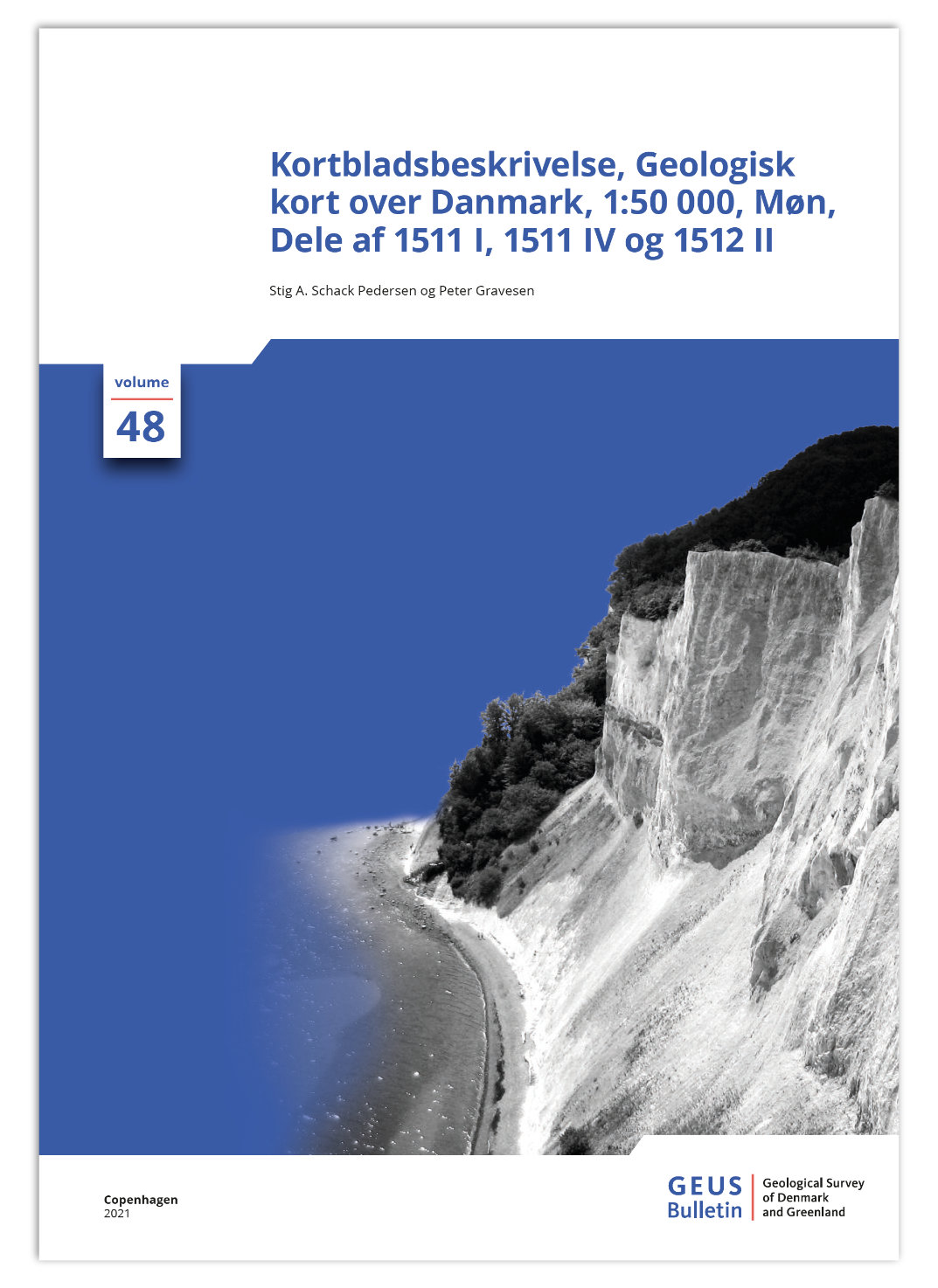
Kortbladsbeskrivelse, Geologisk kort over Danmark, 1:50 000, Møn Dele af 1511 I, 1511 IV og 1512 II
Vol. 48 (2021)Den geologiske kortbladsbeskrivelse af Møn omfatter foruden hovedøen Møn tillige øerne Nyord, Degneholm, Lindholm og Langø. Desuden er det sydøstligste hjørne af Sjælland, Kalvehave, og det nordøstligste hjørne af Falster, Grønsund, medtaget på kortbladet.
Kortbladsbeskrivelsen giver den systematiske, geologiske beskrivelse af jordarterne, som forekommer på det geologiske kort. Desuden indgår beskrivelsen af geologien ned til en dybde af 60–80 m u.h.o., som er repræsenteret ved fire geologiske tværsnit baseret på boringerne i GEUS’ boreprøve-database Jupiter.
De overfladenære geologiske forhold på Møn domineres af moræneler, som dækker ca. 70% af landområdet. Sandede aflejringer, som dækker ca. 20%, består henholdsvis af smeltevandssand og marint sand. Sidstnævnte danner halvøen Ulvshale med et udbygget krumodde-system og den marine sandflade øst for Nyord. I dalstrøgene findes Postglacialt tørv mellemlejret af ferskvandssand og -ler, hvilket især er karakteristisk for opfyldningen af den tidligere fjordarm ved Borre Sømose.
Den mest markante geologiske dannelse på Møn er skrivekridtet på Møns Klint. Her danner en serie stejlt stående flager af skrivekridt parallelle bakkerygge i landskabet, hvor det højeste punkt er Aborre Bjerg 143 m o.h. Flager af skrivekridt findes ikke kun ved Møns Klint, men indgår mange steder i landskabets opbygning, som f.eks. langs Hvideklint på sydkysten af Møn.
This volume is available in English: Vol. 51 (2022).
-
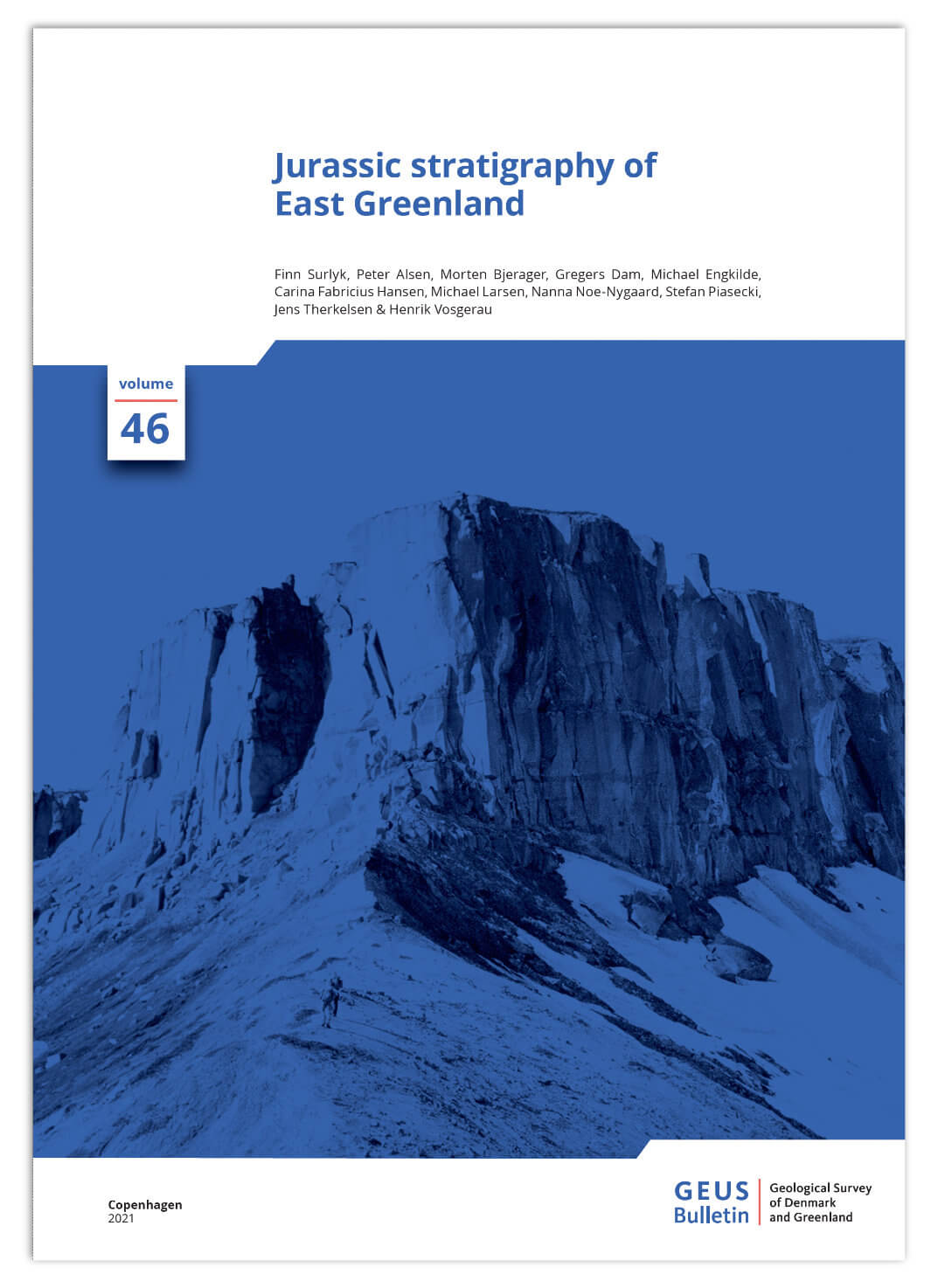
Jurassic stratigraphy of East Greenland
Vol. 46 (2021)The Jurassic basin of East Greenland has an international reputation not only for its well-exposed examples of rift-related depositional systems but also as a source of direct analogues for the subsurface of the Norwegian shelf and the North Sea. In addition, the basin has played an important role over many years in research into Boreal Jurassic biostratigraphy and ammonite taxonomy. A well-constrained stratigraphic framework is an essential component of basin analysis, and understanding of the stratigraphy of the Jurassic in East Greenland has advanced in the last decades in parallel with intensive sedimentological, sequence stratigraphic and palaeontological research.
The aim of this bulletin, therefore, is to present a comprehensive, well-illustrated revision and up-date of the Jurassic stratigraphy of East Greenland to guide and constrain research efforts in future years. The Jameson Land Supergroup spans from the uppermost Triassic to the lowermost Cretaceous and comprises five groups that together include a total of 25 formations and 48 members. Many of these units are revised in this bulletin, and three new formations and 14 new members are introduced.
-
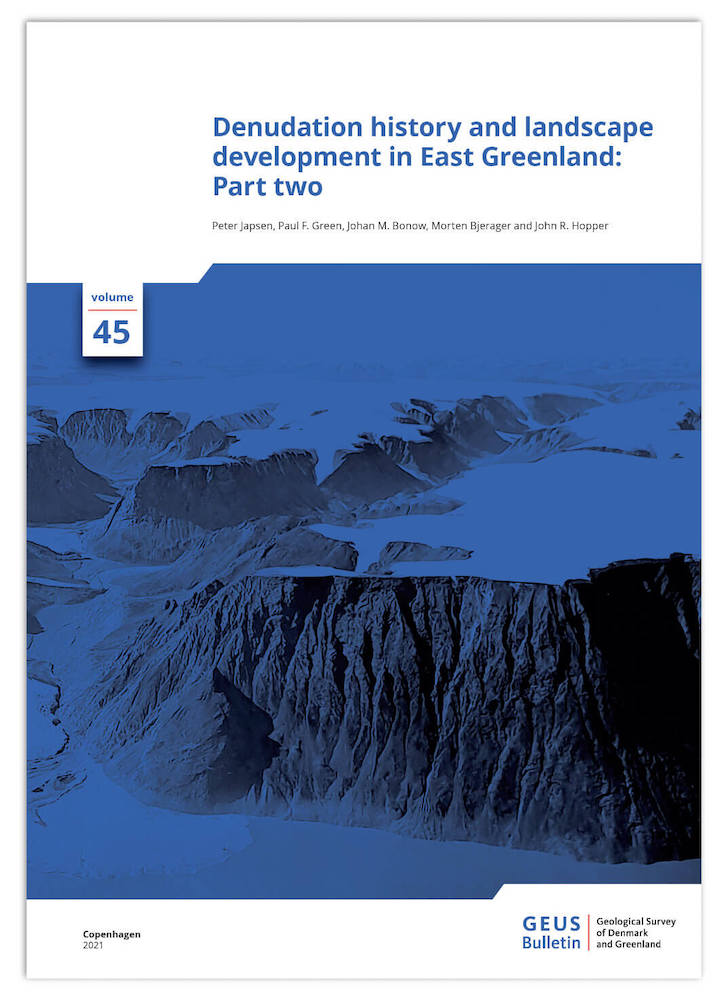
Denudation history and landscape development in East Greenland: Part Two
Vol. 45 No. 2 (2021)The geology of East Greenland north of 70°N – including the Wandel Sea Basin – exposes unique evidence of the basin development between the Devonian collapse of the Caledonian Orogen and the extrusion of volcanics during Palaeogene break-up of the North-East Atlantic. Do the unconformities in the stratigraphic record represent periods of stability and nondeposition? Or do the unconformities represent periods of subsidence and accumulation of rocks followed by episodes of uplift and erosion which removed those rocks? How do the flat-topped mountains fit into the tectonic framework of the region? And when did these elevated plateaus reach their present elevation? To answer such questions, we have used apatite fission-track analysis (AFTA) and vitrinite reflectance (VR) data together with stratigraphic landscape analysis and observations from the stratigraphic record to study the denudation history and landscape development of East Greenland.
In three separate, but interrelated papers, we present the results of these investigations. We show that episodes of kilometre-scale vertical movements (both ups and downs) have affected East Greenland and areas beyond, before as well as after the opening of the North-East Atlantic. Part two consists of a single monograph. Two shorter papers are published in part one.
-
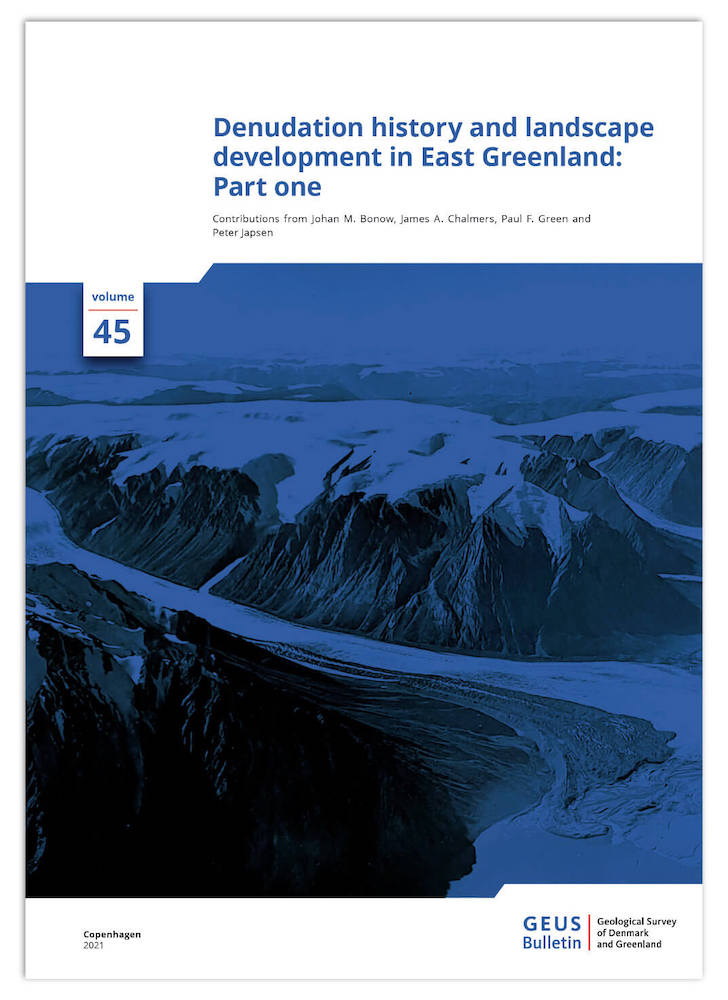
Denudation history and landscape development in East Greenland: Part One
Vol. 45 No. 1 (2021)The geology of East Greenland north of 70°N – including the Wandel Sea Basin – exposes unique evidence of the basin development between the Devonian collapse of the Caledonian Orogen and the extrusion of volcanics during Palaeogene break-up of the North-East Atlantic. Do the unconformities in the stratigraphic record represent periods of stability and nondeposition? Or do the unconformities represent periods of subsidence and accumulation of rocks followed by episodes of uplift and erosion which removed those rocks? How do the flat-topped mountains fit into the tectonic framework of the region? And when did these elevated plateaus reach their present elevation? To answer such questions, we have used apatite fission-track analysis (AFTA) and vitrinite reflectance (VR) data together with stratigraphic landscape analysis and observations from the stratigraphic record to study the denudation history and landscape development of East Greenland.
In three separate, but interrelated papers, we present the results of these investigations. We show that episodes of kilometre-scale vertical movements (both ups and downs) have affected East Greenland and areas beyond, before as well as after the opening of the North-East Atlantic. Part one consists of two papers. A third, longer paper is published in part two.

